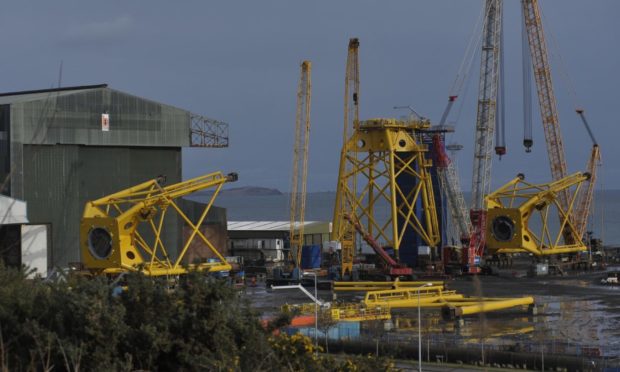Decades of underinvestment have left Scotland’s ports and manufacturing yards unable to compete internationally for windfarm projects, say experts.
Bosses from Scottish and Southern Energy (SSE) and EDF appeared before MSPs on Tuesday, where they described the prohibitive costs they claim prevent them from using Scottish yards like BiFab in their developments.
Matthieu Hue, CEO of EDF Renewables UK, noted BiFab’s costing for providing materials for the company were 10% higher than European costs and even more so than what was being offered by companies in the Far East, like South Korea and China.

Because of the CfD (contract for differences) applied to renewables developments, he added, companies need to always opt for the cheapest production cost.
Why Scotland misses out
Richard Lyle, SNP MSP for Uddingston and Bellshill, asked Jim Smith, managing director of SSE Renewables, why Scotland is missing out on work.
Mr Smith said: “We have tried, more than most, to support the Scottish supply chain.
“We invested £10 million equity in BiFab in 2011, which we effectively gave away for £1 when the company went into administration.
“We put another £7 million into BiFab to stop it going into administration. We stepped in to save the Wind Towers factory earlier in the decade and kept it going until a manufacturer could buy it.
“We have tried to make an impact to the supply chain but it is for manufacturers, ultimately. It seems an overly simple message but as long as we have to compete on price, we have no option but to seek out the lowest cost supplied, otherwise we do not have a project.”
The chances of windfarm jackets being made at BiFab are very slim indeed because we are running out of time.”
Matthieu Hue, EDF
Matthieu Hue, director at EDF, added: “We worked very hard with the contractors for the jackets to get them manufactured at BiFab. That was a year ago… ultimately BiFab has not been able to follow through and provide the guarantee it needs to sign the contract.
“We are in the situation where the windfarm needs the jackets to be manufactured somewhere. The chances of this happening at BiFab are very slim indeed because we are running out of time.
“We have commitments to shareholders and the wider supply chain and if we do not have jackets, we do not have a project.
“We worked extremely hard to make this happen and we are in the unfortunate position now where BiFab will not be making these jackets.”
Apples and oranges
Asked why European companies are beating Scottish companies on bids, Nick Sharpe, director of communications at Scottish Renewables, said there were “many reasons”.
He said: “Denmark built the world’s first windfarm in 1991. Europe has moved since then to invest in its manufacturing and port capacity, when the UK has not.
“That is a fundamental failure in investment strategy from governments over many decades.
“We are talking about very large, complex pieces of equipment which have been built to a very high standard.
“Speaking to some of our members, we talked about facilities in Scotland and the phrase apples and oranges came up.
“A report into fabrication facilities in Scotland said ‘large ports with excellent logistics, with efficient goods in and out routes for thousands of tonnes of raw materials, the UK has no equivalent of Esbjerg in Denmark, Rotterdam in the Netherlands and Rostock in Germany.
“Everyone has a part to play in the success of supply chain companies — government, industry and the companies themselves.
“Unfortunately, it is the case investments which could have been made over the past decades, which would have seen the UK able to compete with European supply chain companies on things like fabrication, simply were not made.
“We have been left with this apple and orange situation and it is unfortunate.
“We are doing things about it now, but it’s notable 3% of Denmark’s GDP comes from wind energy products. We will always be at a disadvantage so we should focus on areas we can succeed.”
EDF claim to have tried to use Scottish yards
Mr Hue said EDF is committed to working with Scottish and UK supply chains. “When we start a project we are proactive in reaching out to companies (local) which might benefit from it,” he said.
“If we use the NnG project, for example, which started construction earlier this year, a very thorough exercise of tendering the various parts of the project for jackets for offshore turbines.
“In each of these contracts, for tier one suppliers, we ask them to consider where they would get local content.
“In the case of the jackets for NnG, we asked contractors to look at opportunities to work with BiFab.
“What we found is, BiFab is not able to compete on price. The differential was 10-15% on what we see in Europe and even more outside Europe.
“In a world where we have to compete through a CfD, where we have to opt for the lowest price offered, it is very difficult to pay a premium. We are, in fact, unable to pay a premium or we will lose the contract and not be able to do the development, at all.
“That does not mean we are not making the effort. We did work hard to try to secure BiFab the jacket contract.
“Without strong investment this situation means (companies) cannot compete. We need strong investment…it cannot be done on an ad-hoc basis.”
Bids were “competitive”
A Scottish Government spokesperson said: “BiFab was competitive with other yards in the rest of the UK and Europe in its latest bid for the SSE Seagreen work.
“But BiFab was undercut by UAE and China as the UK’s Contract for Difference rules encourage a race to the bottom on the cheapest low-cost labour rather than giving precedence to supporting domestic supply chains.
“There have been no plans put forward for BiFab by the majority shareholder for this type of investment.”


